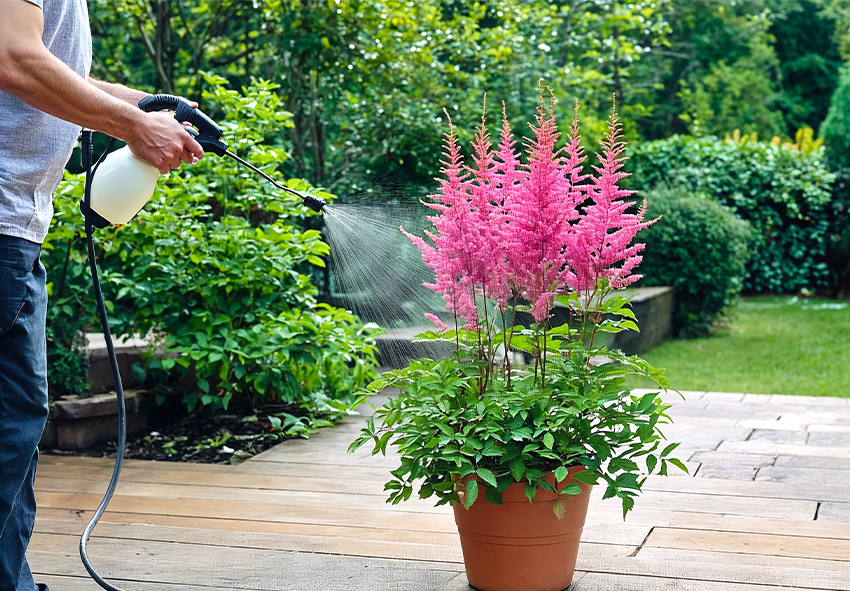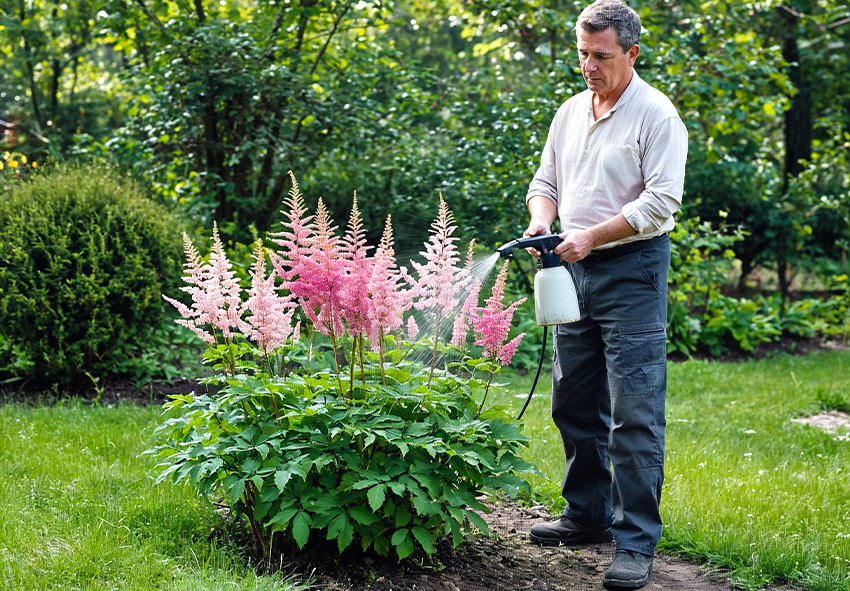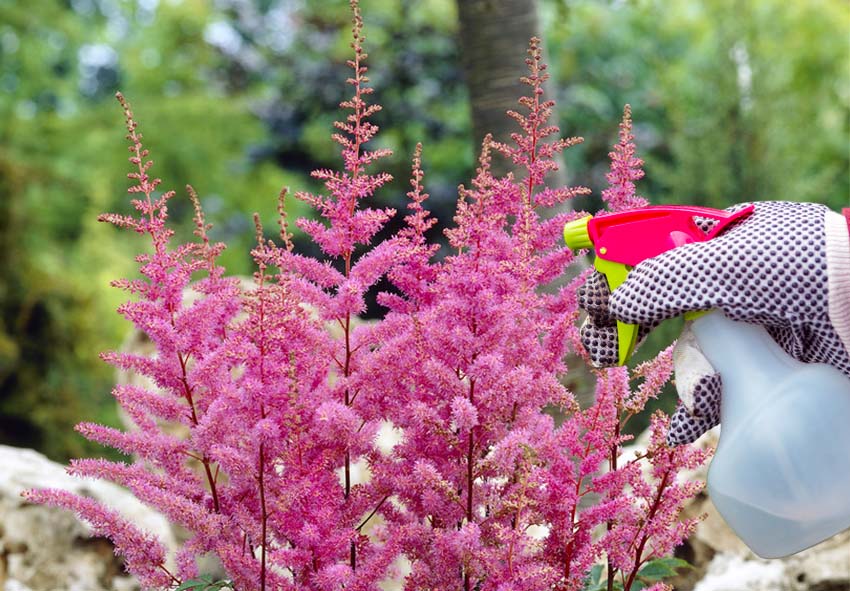Astilbe is a beloved shade-loving perennial known for its feathery plumes and lush foliage, adding elegance to gardens and shaded borders. While generally hardy, astilbe can suffer from pest problems if not properly monitored. Effective pest control for astilbe ensures long-lasting blooms, healthier plants, and a more resilient garden. This guide explores the most common pests, preventive strategies, and both natural and chemical control methods. Our gardening blog is a perfect place to find any information you need!
Common Pests of Astilbe

Although astilbe is not the most pest-prone perennial, it can still fall victim to several garden pests. Knowing how to identify these issues early is essential for successful astilbe pest management. Below are the most common pests that affect this plant.
Aphids
Aphids are tiny insects that cluster on stems and leaves, feeding on plant sap. Their presence often causes curled foliage and a sticky residue called honeydew, which can attract sooty mold. Controlling aphids early with sprays of water, insecticidal soap, or natural predators like ladybugs keeps your astilbe healthy.
Slugs and Snails
Shady gardens, where astilbe thrives, often attract slugs and snails. These pests chew irregular holes in the leaves and leave slimy trails across the foliage. Handpicking, using copper barriers, or applying organic slug pellets are effective ways to minimize their damage.
Spider Mites
Spider mites become problematic in hot, dry conditions. They cause yellowing, speckled leaves and fine webbing on the undersides. Regular misting, neem oil sprays, and maintaining humidity are effective strategies to control these pests.
Vine Weevils
Vine weevils feed on the roots of astilbe, causing plants to wilt or die suddenly. Their larvae are especially destructive underground. Nematodes or specialized insecticides are the most reliable methods for managing vine weevil infestations.
Preventive Pest Control for Astilbe
Prevention is the best defense when it comes to pest control for astilbe. Healthy, well-spaced plants are less likely to attract harmful insects and diseases. Implementing good gardening practices helps reduce the risk of infestations. By focusing on prevention, you ensure your plants stay vigorous and less prone to stress. A strong astilbe plant naturally resists pests better than a weak one.
Proper Plant Spacing and Air Circulation
Astilbes planted too closely create a humid environment that pests and fungi love. Adequate spacing improves air circulation, making conditions less favorable for infestations. This also reduces the spread of fungal diseases like powdery mildew. Proper airflow helps your astilbe thrive in shaded areas where humidity tends to build up.
Mulching and Soil Care
Mulching helps retain soil moisture while also acting as a barrier against pests like slugs. Choosing organic mulch also enriches the soil, boosting plant health and resilience. Well-nourished soil ensures stronger root systems, making your plants less vulnerable to stress. A balanced environment around the root zone discourages many pests.
Encouraging Beneficial Insects
Beneficial insects play a vital role in keeping pest populations under control naturally. By attracting these garden allies, you reduce the need for chemical treatments and create a healthier, more balanced ecosystem. Supporting beneficial insects also promotes pollination, helping your astilbe and other plants thrive:
- Plant Insect-Friendly Flowers: Grow nectar-rich plants like dill, fennel, or yarrow to provide food sources for ladybugs, lacewings, and hoverflies.
- Provide Shelter: Small piles of twigs, rocks, or insect hotels give beneficial insects a safe place to live and reproduce.
- Avoid Broad-Spectrum Pesticides: Harsh chemicals kill both harmful and helpful insects, so opt for natural pest control methods whenever possible.
- Companion Planting: Add marigolds, chives, or lavender near astilbe to draw in pollinators and predatory insects.
Natural Pest Control for Astilbe

Many gardeners prefer eco-friendly solutions for astilbe pest management. These methods are safe for pollinators and the environment while still being effective. Natural remedies are also more sustainable, reducing reliance on chemicals. They promote long-term plant health while supporting garden biodiversity.
Handpicking and Barriers
Slugs and snails can be controlled by handpicking during the evening. Copper tape and physical barriers prevent them from reaching your plants. These methods are cost-effective and safe for both children and pets. Regular inspections ensure you stay ahead of infestations.
Homemade Sprays
Garlic or neem oil sprays deter aphids and mites without harming beneficial insects. These should be applied regularly for best results. Homemade sprays are easy to prepare and budget-friendly. They work best as part of an integrated pest management routine.
Companion Planting
Plants like garlic, chives, or marigolds naturally repel pests. Companion planting improves garden diversity and helps protect your astilbe. This method also beautifies your garden with a mix of colors and textures. Strategic planting reduces the need for chemical treatments.
Chemical Pest Control (When Necessary)
While natural methods are preferred, sometimes chemical treatments are required for severe infestations. Use them cautiously to protect pollinators and other beneficial insects. Chemicals should always be a last resort, not the first line of defense. Limiting their use helps preserve the balance of your garden ecosystem.
Targeted Insecticides
In cases of severe infestations, targeted insecticides can provide effective control without harming the entire garden ecosystem. These treatments focus on specific pests while minimizing the impact on pollinators and beneficial insects. Using the right product at the right time ensures that your astilbe remains healthy and pest-free:
- Identify the Pest First: Always confirm whether you’re dealing with aphids, vine weevils, or other pests before applying treatment.
- Choose Narrow-Spectrum Products: Opt for insecticides that specifically target the identified pest instead of broad-spectrum chemicals.
- Apply at the Right Time: Spray in early morning or late evening to reduce harm to bees and other pollinators.
- Follow Label Instructions: Overuse or misuse can stress plants and harm soil health, so always stick to recommended guidelines.
- Combine with Other Methods: Use insecticides alongside natural controls and preventive practices for sustainable long-term results.
Application Guidelines
Spray in the early morning or evening to avoid harming bees. Always follow label instructions and avoid overuse. Wearing protective gear is important to ensure your safety. A careful approach helps reduce environmental impact.
Monitoring and Long-Term Pest Management

Astilbe requires ongoing care to remain pest-free. Consistent monitoring allows you to catch problems before they escalate. Long-term astilbe pest management combines prevention, early action, and seasonal adjustments. A steady routine reduces plant stress and keeps pests under control year after year.
Early Detection Tips
Inspect leaves regularly for holes, discoloration, or sticky residue. Addressing pests early keeps infestations manageable. Regular checks also prevent small problems from spreading across the garden. A magnifying glass can help spot tiny pests like mites.
Seasonal Maintenance
Seasonal care for astilbe is an important part of pest contro. By adjusting your routine throughout the year, you can prevent infestations, keep plants strong, and reduce the chances of recurring problems. Each season requires specific tasks that help your astilbe remain healthy and vibrant:
- Spring Care: Inspect new growth closely for pests like aphids and mites. Apply mulch to retain moisture and reduce weed competition.
- Summer Monitoring: Water regularly during dry spells and check leaves for discoloration or chewed edges. Address pest issues early before they spread.
- Fall Cleanup: Remove fallen leaves and plant debris to eliminate overwintering sites for slugs and fungal spores. Divide overcrowded plants if necessary.
- Winter Preparation: Protect roots with a layer of organic mulch. Cut back dead foliage to discourage pests from hiding until spring.
Conclusion
Astilbe can stay vibrant and pest-free with a combination of preventive measures, natural remedies, and targeted treatments when necessary. By recognizing common pests of astilbe early and applying proper management techniques, you can enjoy lush, long-lasting blooms year after year. A balanced approach to pest control for astilbe ensures healthier plants and a thriving garden!
Frequently Asked Questions (FAQs) about Pest Control for Astilbe
1. What are the most common pests of astilbe plants?
Astilbe plants are often affected by aphids, spider mites, slugs, snails, and vine weevils. Each pest causes different damage, from leaf curling to root destruction. Identifying these problems early helps in applying targeted pest control and ensures that your astilbe stays strong and vibrant in the garden.
2. How can I prevent pests from attacking my astilbe?
Prevention starts with proper spacing for air circulation, mulching to keep soil healthy, and inviting beneficial insects like ladybugs. Keeping the garden clean and avoiding overwatering also reduces pest risks. Healthy, well-maintained astilbe plants are naturally more resistant to pests.
3. Are there natural pest control methods for astilbe?
Yes, natural pest control for astilbe includes handpicking slugs, using copper barriers, applying neem oil or garlic sprays, and companion planting with pest-repelling plants like marigolds. These eco-friendly methods protect your astilbe without harming pollinators or beneficial garden insects.
4. Can I order Holland Astilbe from your online store?
Yes, you can! Our online store Dutch-bulbs.com offers a wide selection of Astilbe plants, including different varieties and colors. We take pride in providing top-quality plants that are carefully cultivated and shipped with care to ensure they reach you in perfect condition.
5. When should I use chemical pest control on astilbe?
Chemical pest control should only be used when natural methods fail, especially against severe infestations like vine weevil larvae. Always use targeted insecticides rather than broad-spectrum ones, and follow application guidelines carefully to avoid harming bees and other beneficial insects.
Published: 23.09.2025
